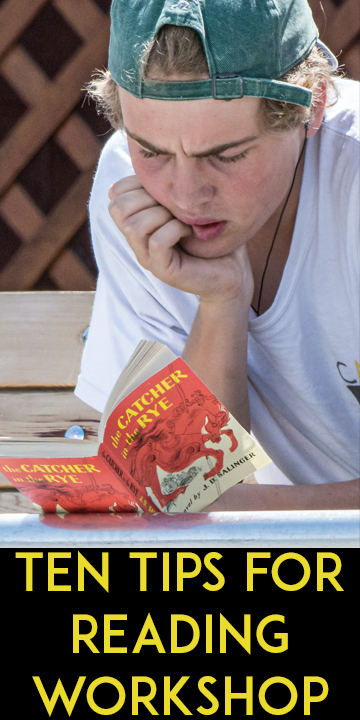Ten Tips for a Successful Reading Workshop

I have come to admit that my students get more out of the books they choose to read on their own than almost anything I assign to them. I also know that their lives don’t always allow them time to get lost in a book while they are surrounded by a quiet, calm atmosphere. So when I can, I structure in some time for independent reading workshop including writing regular reading responses based on one of two different structures.
I have honed and refined my routines and expectations over the years, until reading workshop is a highlight for my students—and for me!
Here are my top 10 tips for conducting a fun and rigorous reading workshop.
- Buy books for your classroom library, but don’t get super expensive ones. Sticking to thrift store finds of $1 or $2 means that you won’t go bankrupt if those books never make it back. But being able to hand a book to a kid who forgot their own will really help you to keep the momentum and to help those kids from distracting their classmates.
- Spend a luxurious day exploring books. Before you schedule any workshop days, spend a whole class period getting books into kids’ hands and getting them excited about reading those books. Spend a day strolling around the library together if you can! Pull out some books that you have enjoyed or that you think they might like. Have kids bring books from home that they want to read or that they think a friend might like. Ask the school librarian to present some new arrivals. And let your students know that they can always stop reading if a book doesn’t work out.
- Schedule time for reading. If your students think that reading workshop is something that you tack on when you have extra time or don’t feel like teaching, they’ll never take it seriously. Plan to dedicate a regular day each week or a group of days together or even a few weeks to silent reading and reflection. This will give your students the message that you value reading and want them to as well.
- Establish routines and accountability. After years of trying different strategies to get kids focused, quiet, and reading in class, I decided that the best method is a check-in at the beginning of class and at the end. I go around from student to student, taking note of what they are reading and what page they are starting at. Of course, sometimes I can’t resist a comment or question on their book, but I try to keep it quick. At the end of class, I go around again, writing down page numbers where students ended their reading. This gives me a good sense of how much they can read in a given time (helpful for assigning reading for homework) and whether or not that kid in the back row really did fall asleep or not. Just this bit of accountability is enough for most students to stay on track during class.
- Show them you read too. If at all possible, spend at least some of the time that your students are silently reading working on your own reading as well. Modeling life-long learning is invaluable! (And also, sometimes you need to just spend the class grading the quizzes that have been sitting on your desk for a month and that’s okay too.)
- Create a system for keeping track of loans. If you do decide to loan out books that you buy for a classroom library, figure out how you are going to keep track of which books are with which students. A simple list in your top drawer might suffice, but if you want to see those books again, figure out some way to keep track.
- Take students through a reading response step by step. Before you assign reading responses, spend a the whole class working step by step through one of the reading response formats with your classes. It might seem like a slow process, but when students really pause to work through the steps, they get a ton out of it. After that focused day, they’ll be writing and analyzing independently.
- Really respond to their reading responses. I have seen fellow teachers grade student responses with nothing more than a check and a “nice job.” Even though I only read a fraction of what students write, I want them to value the experience and I want them to know that I really care about what they have to say. So I always make it a point to respond specifically to their ideas, to ask questions about their reading, and to let them know that I have paid attention to their thoughts.
- Talk to your kids about what they are reading every chance you get! Asking students about their books when you have a few minutes at the end of class or you have them in your study hall reminds them that you care about their interests and that you are a reader too. I’ve also found that over the years I can recommend books that I haven’t even read myself because students have given such glowing reviews.
- Rinse and Repeat. Now that you’ve got the basics down, you can spend as many days as possible on reading workshop. Come back to any of the previous day’s plans whenever needed. Students running out of books they want to read? Take a class trip to the library or present a few from your classroom library. Your classes need a refresher on reading responses? Spend a few minutes looking at a stellar student example and talking about what makes it great. Your students are bursting to share books they have loved? Work in some book presentations or informal sharing or a gallery walk with brief written summaries or reviews.
Reading workshop isn’t always easy—trying to get an entire class of students to settle down and focus can feel like herding cats while simultaneously putting out fires! But when you see that one student who has never enjoyed reading sitting quietly and devouring a book, you will know that your efforts are worth it.
Creating a culture of reading is a priceless gift to give to your students and a great way to show them that you care about their interests.
